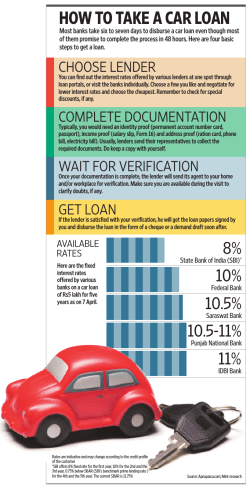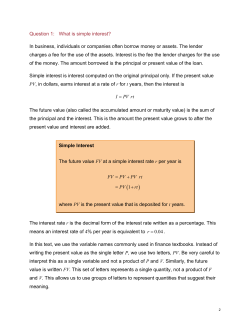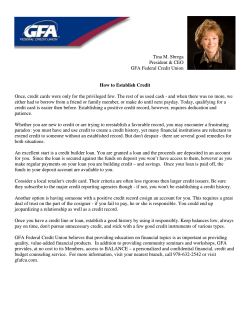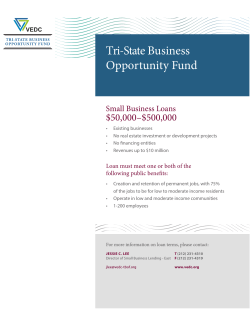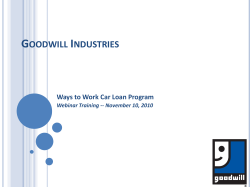
Commercial Real Estate Workout/Restructure Services
Commercial Real Estate Workout/Restructure Services 1 Commercial Real Estate Lending 2 Take Out Financing SMALL BALANCE BRIDGE FINANCING from $ $50k to $500k Nationwide Program Equity Based Underwriting Owner User/Investment Properties Close in 10 days Unique Property Types Direct Lender – Private Equity Fund 3 Take Out Financing COMMERCIAL BRIDGE FINANCING $500k to $50MM Situational Lending Foreclosure Bailout Verbal funding f Close in 10 days Direct Lender – Private Equity Fund 4 If nott financeable fi bl att levels l l you need d or debt is to expensive / troubled Asset situation What do you do? Hire Counsel – Very Expensive R Reorganization i ti Pl Plan – Not N t legal l l advice/business d i /b i Pl Plan Foreclosure Bailout Spend monies on due diligence/appraisal fee’s fee s - don don’tt get anywhere You need professional creative solutions Are you in a troubled asset situation 5 Life Cycle of a Troubled Asset Performing Loans Acquisition Loan Development Loan Construction Bridge or Gap Loan Loan Permanent Loan Loan on raw un‐ zoned land through rezoning and entitlements. Typically interest only and rolls into a development l loan. Loan on zoned land and horizontal improvements (i.e. utilities and streets). Typically interest only. Loan on developed tract for vertical improvements. Typically interest only and may contain a rollover provision. Long‐term loan based upon property performance (debt service coverage ratio, loan to value ratio, etc.). Short‐term loan prior to permanent loan. Often used until property achieves stabilized occupancy. Life Cycle of a Troubled Asset Non‐Performing Loans Performing Loan Default May be monetary or non‐monetary default. Loan Workout Non Performing Loan modification, restructure, pay off, sale, receivership, bankruptcy, foreclosure, deed‐in‐lieu, etc. Module 1 – Page 7 Causes of Default Monetaryy default – Failure to fulfill direct financial requirements Non-monetary default aka technical default – – – – Failure to fulfill loan covenants (LTV, DSCR, etc.) Borrower declares bankruptcy Un consented transfer Waste of the asset When Loan is in Default Lender has two primary courses of action – Foreclosure and manage or liquidate collateral – Work the problem out with the borrower Borrower has two primary courses of action Borrower has two primary courses of action – Work the problem out with the lender – File bankruptcy – 99 out of 100 Chapter 11 filings end up in Chapter 7 Life Cycle of a Troubled Asset REO or OREO Non Performing Asset Management Asset Marketing & Disposition Sold or Performing Asset Management and Disposition Plan (AMDP) Module 1 – Page 10 Performing Banking Relationship B Bankk Core Capital (Equity 10%) (Equity 10%) Other Assets: Stocks Bonds Loans Real Estate Liabilities: Deposits R lE t t Real Estate Fully Capitalized $0 Loan $ Loss Reserves Property Value 20% Equity 80% Debt (Performing) Non-Performing Non Performing Banking Relationship B Bankk Core Capital (E i (Equity <10%) 10%) Other Assets: Stocks Bonds Loans Real Estate Liabilities: Deposits R lE t t Real Estate Under Capitalized $$ $$ Loan Loss Reserves Property Value No Equity 100% Debt (Non‐ Performing) Triggers: Classification Loan Covenants Module 1 – Page 12 Foreclosure and Real Estate Owned B Bankk Core Capital (E i (Equity <10%) 10%) Other Assets: Stocks Bonds Loans Real Estate Liabilities: Deposits R lE t t Real Estate Under Capitalized $$ $$ Loan Loss Reserves Original Value Appraised Value Foreclosed Real Estate IIssues Aff ti T bl d A t Affecting Troubled Assets External Influences External E t l Influences I fl Market/Economy Internal Influences Internal I t l Influences I fl Building/Tenants Property Owner Influences Lender Influences External Factors on Troubled Assets Condemnation Job Losses New Construction New Construction Declining Rents Property Traffic Patterns Traffic Patterns Area Deterioration Crime Market Vacancies Internal Factors on Troubled Assets Poor Management Poor Management Deterioration Rental Rate Decline Rental Rate Decline Tenant Bankruptcy Property Expense Escalations Expense Escalations Obsolescence Catastrophe Lease Terminations Owner Factors on Troubled Assets Declining Health Declining Health Poor Decisions Partner Problems Partner Problems Death Property Investment Declines Bankruptcy Credit Issues Job Loss Lender Factors on Troubled Assets Loan Covenants Loan Covenants Regulatory Requirements Portfolio Loads Portfolio Loads Debt Service Coverage Ratio Property Loan‐to‐Value Ratio Loan‐to‐Value Ratio Appraisal A i l Requirements Participants Loans‐to‐One Borrower Impact of Reduced Income DSCR issues with lender Loan to value issues with lender Loss of rent Revenue declines or Expense increases (non‐payment or rent relief) Deferred maintenance Inability to pay property management Inability to make Inability to make mortgage payments Inability to pay taxes Inability to pay taxes Owner’s Owner s Decision Tree Distressed Owner Declining Revenue Reposition Restructure Debt Increasing Expenses Bankruptcy Deed in Lieu Voluntary Sale Change Management Modify Covenants Chapter 11 (individuals) With Deficiency Single Asset Change Change Leasing Rate Rate Reduction Chapter 13 Chapter 13 (individuals) Without Without Deficiency Portfolio Rent Vacant S Space Cash Flow Mortgage Chapter 7 ( (companies) i ) Auction or S l d id Sealed Bid Lender’s Lender s Decision Tree Lender Personal Guarantee Sell Loan No Guarantee Loan Renewal Deed in Lieu Loan Workout Foreclosure Foreclosure Hold Seek Deficiency f Liquidate Distress Actions Workout Distressed Distressed asset Foreclosure or Foreclosure or deed in lieu Cash flow mortgage Debt service moratorium Debt service moratorium Interest rate reduction Increase amortization period R fi Refinance Alter DSCR and L/V ratios to avoid default Negatively amortized mortgage Reposition property Lease the property to add value Hire property management company Hire leasing company Assign receiver Immediate disposition Hire brokerage company Factors Influencing Lender Lender’s s Decision Liquidity q y position p and abilityy to p pay y off loan Whether borrower acted competently and in good faith (relationship) Physical condition of property and environs Condition of market (most prevalent non-recourse) Level of lender control and amount of loss sustained Probability of a turnaround to profitability The Workout A jjoint effort between a borrower and lender to cure a loan default through strategic actions and negotiated compromise In I lieu li off fforeclosure l and/or d/ b bankruptcy k t Includes owner’s efforts to increase income, cut expenses, and maximize value during interim period Everything is negotiable but the negotiating party may be a group effort. Workout Advantages to Lender Banks are in the business of making g money y on loans— not owning troubled real estate Lenders can face “lender liability” as a borrower defense ( (ex. D’O D’Oench h Duhme D h D ti ) Doctrine) Foreclosure doesn’t necessarily improve financial picture—just picture just moves asset’s asset s management Foreclosure can cast a stigma on a property, tainting its marketability Workout Advantages to Borrower While bankruptcy p y can stall p proceedings g on a foreclosure,, the borrower forfeits any chance of salvaging equity once foreclosure occurs An A antagonistic t i ti response to t the th d default f lt can severely l damage credit standing and reputation The stigma of bankruptcy can prevent owners from ever being able to raise capital again Bankruptcy is expensive in a down market Lender Liability Not all lenders are consistent in documentation or negotiations with borrowers. Can be by design but most times just “sloppy work”. – Adds new conditions to the loan after borrower accepts original terms – Improperly uses acceleration and demand clauses – Calls a loan due in unreasonable amount of time – Stalls the loan process Cash Flow Mortgage Also called “negative g amortization mortgage” g g Applies all available net income to debt service Applies all unpaid amounts to the outstanding principal as additionally borrowed funds When loan matures, unamortized balance is due and payable including all unpaid interest payable, Debt Service Moratorium Lender declares moratorium on debt service payments p y Not debt forgiveness—unpaid interest and principal accrue additional interest until loan is paid off Same as the cash flow mortgage, without monthly payment In many cases there is no available cash flow anyway Interest Rate Restructure Interest rate is lowered De facto refinancing Lender may add additional covenants such as shortening the term or eliminating rollover provisions Other Loan Modification Options Loan term can be lengthened g Payments can be deferred or forgiven Lender can exchange interest or principal payments for equity (private lenders only) Lender can advance additional funds as unsecured credit or as a loan secured by additional borrower credit, collateral (almost non-existent this cycle except for construction projects) What if Workout isn’t isn t Viable? Lender must liquidate q to recover all or p part of loan asset – Voluntary sale – Deed in lieu of foreclosure – Foreclosure Note: N t Settlement S ttl t and d Workout W k t discussions di i may or may not be admissible in any future litigation depending on anyy Settlement Agreements. Check your bank’ss financial health Check your bank financial health http://www.fdic.gov Foreclosure 101 Legal g right g of lender to g gain ownership p of the asset and/or the right to sell the asset to pay off a loan that is in default Two T widely-used id l d ttypes off foreclosure f l – Judicial – Power of sale (non-judicial) (non judicial) Judicial Foreclosure Available in everyy state;; required q byy manyy Sale of asset done under supervision of court Proceeds first satisfy loan, then other lien holders, then mortgagor Right of Redemption Non-Judicial Non Judicial Foreclosure Available in most states ((29 currently) y) Sale of the property by the mortgage holder is NOT done through the supervision of a court – Sale usually authorized by public or private trustee More expedient Proceeds first satisfy loan loan, then other lien holders holders, then mortgagor Typical Foreclosure Process Notice of Default Notice of Sale Sale/ Auction (to bank, 3rd party, etc.) Transfer of Mortgage or Deed Redemption Period (in some (in some cases) Bankruptcy Most p protective unilateral action borrower can take once lender has opted to foreclose Defined as a condition of financial insolvency where a d bt iis unable debtor bl tto pay currentt d debts bt Threatens lender with interminable delay and financial expense Judiciary is not always predictable! Bankruptcy Objectives j – Ensure that debtor's assets are distributed to creditors equitably and in an orderly fashion – Protect P t td debtor bt from f actions ti that th t would ld preclude l d ability bilit tto rehabilitate their business Automatic stayy Reorganization - Chapter 11 Liquidation - Chapter 7 (corporations) and 13 (i di id l ) (individuals) Workout/Restructure Planning Services 40 Restructure Services Document Collection Borrower/Property Transparency Restructure Plan Multiple Workout Strategies 41 Sample of Strategies customized to your situation Take Out Financing individual Loan/Note Equity Infusion /3rd Party Assumptions Borrower/Property Transparency/Reporting Voluntaryy Receiverships p – Short term debt for benefit of Borrower/Bank in spirit of workout Tenant/Owner Creative Restructure or Disposition St t i Strategies Equity Lease’s 42 Introduction To Banks Explain LNB Goals Non N adversarial, d i l N Non llegall approach h Key Documents: – Pre-Negotiation Pre Negotiation Agreement – Authorization to Represent 43 Adding Value to Both Borrower’s Borrower s and Lenders 3rd party- Non emotional party We speak the Banks “language”, we are not the Bank More M costt effective ff ti th than B Borrower Counsel/Bank Counsel 44 Restructure Plan Executive Summary Current Situation Distressed Property Valuation Multiple Cash Flow Scenario’s Loan Restructure Proposal Summary 45 Net Present Value Comparison’s M ar k e t As s um ptions Wor k out Options Discount Rate 6% Cap Rate 10% Option Chosen Or iginal Loan Infor m ation Original A mount 3 1) Paym e nt Re duction $1,000,000 A f f ordable DSCR 1.250 360 Modif ied Payment $4,453 240 Ef f ective Interest Rate Original A mortization Term Remaining Term 2.405% Original Interest Rate 6.500% OR Loan Constant 7.585% 2) Inte r e s t Rate Re duction Monthly Payment $6,321 Y early Payment A f f ordable Interest Rate $75 848 $75,848 3.000% Modif ied Payment $4 702 $4,702 Ef f ective DSCR Revenue Potential Gross Rent Other Income V acancy Ef f ective Gross Rent 1.184 OR Pr o for m a A t Origination Current 3) “Se t As ide ” Option $150,000 $150,000 $0 $0 30% 5% $105,000 $142,500 Percentage of Principal to “set aside” 40% Interest Rate on “set aside” 1.000% Interest Rate on Remaining Principal 6.050% Number of Months Set A side 36 Modif ied Payment f or 36 Months % of Gross Rent Expenses Real Estate Taxes $21,000 20.00% Ef f ective DSCR f or 36 Months $6,324 $3,000 2.86% Mgmt Fees $4,250 4.05% 4) Pe r m ane nt Pr incipal Re duction Utilities $2,000 1.90% New Unpaid Principle Balance Supplies $1,200 1.14% Modif ied Payment Ongoing R&M $2,000 1.90% Ef f ective DSCR Other Expenses $2,000 1.90% $35,450 33.76% OR Net Operating Income Re-def ault Rate $69,550 Home Price A ppreciation Forecast TI/LC Reserves Other Reserves Cash Flow Available f or DS DSCR Future Interest and A dvanced Escrow $2,750 REO V alue $66,800 $600,000 $4,473 1.244 Pote ntial for Re -de fault afte r M odification Months to Re-def ault Cur r e nt DSCR 1.412 Payment af ter 36 Months Insurance Total Expenses $3,941 PV Estimated Loss 3 20% -5% $16,983 $511,597 -$318,253 0.881 Ne t Pr e s e nt V alue of Wor k out Option Net Present Value of Loss For e clos ur e Sce nar io UPB $847,761 Current V alue $695,500 Property A ppreciation Forecast REO Stigma Discount -4% 20% Months to Foreclosure 3 Months to REO Sale 3 Foreclosure Costs Future Interest and A dvanced Escrow REO V alue PV Loss Due to Foreclosure Cure Rate $27,552 $506 592 $506,592 -$331,111 Loss Weighted by Chance of Redef ault Business Decision Benef it f rom Modif ication Workout Pass/Fail -$77,638 -$125,761 $139,128 Pass We show the Bank numerically why restructure makes most economic sense f h for them 20% 46 Preserving and Maximizing Value Objectives Evaluate primary assessment areas – Market position p – Physical asset – Income and expenses Maximizing operating income Stabilizing operating expenses Evaluate E l t management, t marketing k ti and d lleasing i Assessment Areas Market and Market and Competitive Analysis Financial Financial Analysis Strategic Analysis •Goals and Objectives •Alternatives Alt ti •Decision Criteria •“Go/No Go” Decision Points Political and Legal Analysis Location & Location & Site Analysis Assessment Areas Physical Asset Physical Asset Market Position Income & Expenses Location & Site Analysis Market Physical Asset Site Module 2 – Page 50 Asset Analysis Parking Exterior Condition Landscaping Curb Appeal Physical Ph i l Asset And Site Common Areas Mechanical Mechanical Systems Tenancy Interior Interior Finishes Property Assessments Conduct exterior and interior property inspections Conduct file inspection (survey, floor plans, etc.) Obtain current title report Obt i public Obtain bli records d ((zoning, i ttaxes, hi history, t etc.) t ) Review Rent Roll, Leases, Maintenance Contracts Interview owner owner, manager and contractors Interview existing tenants and leasing agent(s) Are specialists p required? q ((roof,, mechanical,, etc.)) Asset Evaluations American Society for Testing and Materials • Property inspections • Property condition assessments ASTM E-2018 Site Analysis - STDB Pictometry • • • • • • • Evaluate access Curb appeal Landscaping Parking Exterior condition Surroundings Amenities Exterior Problems • • • • • • • Change g the p project j or p property p y name Resolve ADA issues Overlay or restripe the parking lot Improve the landscaping Change the building or trim colors Upgrade signage and graphics Add security lighting Lobby Problems Add or improve p lighting g g Redo lobby finishes Add artwork Upgrade building directory Add glass to a closed-in lobby Install vestibule doors Building Services Problems Add elevators or lift system y Upgrade security system Add concierge or personal services Add conference facility Improve maintenance services C Change maintenance personnel Change management personnel Tenant Area Problems Change g carpet p and other finishes Add lighting Upgrade HVAC Raise ceiling heights Upgrade entrance doors Upgrade graphics and signage Preserving & Maximizing Value Test all CapEx p metrics ((objective/subjective) j j ) Maintain curb appeal (landscaping, parking) Correct structural problems (foundation, roof) Aesthetics (paint vs. re-siding) Maintain or update common areas Market Factors Employment Government Influence Demographics Community & Area Amenities Market and Market Competitive Position Analysis Absorption Analysis National/Local Economy Occupancy Occupancy Costs Competing Competing Properties Market Factors Demographics Job growth Construction C Competition titi Leasing and sales Social issues Political issues Market Surveys Market Assessment Resources Who We Use Brokerage community and in-house in house resources CCIM Site To Do Business www.stdbonline.com Chamber of Commerce Economic Development Corporation CoStar, Loopnet, RIISnet, Reis Reports, CCIMnet, IRR, RERC, National brokerage companies Appraisers Economists Universities Site Analysis www.stdbonline.com Financial Analysis D di t d Dedicated Employees SService i Contracts Property Management Energy Audit Income & Financial Analysis Expenses p Rent & Other Revenue Lease Audit Tax Appeal Reconciliation Income & Expenses Identifyy and maximize all revenue sources Minimize vacancies & credit dit llosses Eliminate non-essential expenses Minimize essential operating costs Maximizing Revenue Review delinquencies q Review collection policies Are any tenants likely to vacate early? Should non-monetary and/or monetary relief be offered to tenants? Maximizing Revenue Pursue renewal of existing gq quality y tenants Aggressively pursue new tenants Review leases for escalations and bill-backs Bill back operating expense pass-throughs Retail percentage rent collections Identify f other income (signage, ( concessions)) Stabilizing Operating Expenses Appeal pp real estate tax assessments Evaluate property insurance policy and costs Evaluate and manage utilities usage Correct deferred maintenance Eliminate non-essential expenses Property Management Assessment Interview the tenants Evaluate their market and property experience Obtain references and testimonials Evaluate ownership and staff Evaluate vendors and contractors Evaluate accounting capability and reporting Evaluate fees and expenses Maintenance Contracts Review specifications Re-bid – Obtain three new bids Be aware of any relationship of contractors to management or ownership Leasing Problems Almost everyy troubled asset has a leasing gp problem – Time – Rate Never met lease-up projections Rental rates lowered Concessions increase Reduce standards for qualifying tenants Evaluating the Leasing Activities Review leasing g results for the p past yyear Compare results to leasing activities at competing buildings Determine if leasing agent(s) still have enthusiasm and are devoting sufficient time to the property Do you need to hire a new leasing team? Should the property have a dedicated leasing agent? Leasing and Target Marketing Evaluate the marketing g and leasing gp plan: – – – – Identify features and benefits Establish goals and objectives Understand various marketing venues Complete cost-benefits analysis Most prospects are already in the area – Target tenants that “fit” (tenant mix, size, configuration, etc.) Other Issues or Problems Presence of hazardous materials Life safety issues Parking and access Heating and cooling Property insurance Aesthetics Who Repositions the Asset? Current owner – – – – – Are funds available? Raise capital Restructure the loan Willingness to assume risk Sell property with business plan to investor or developer Sell property with business plan to investor or developer Who Repositions the Asset? Lender when p property p y foreclosed – Will lender take the risk of repositioning? – Can lender take the risk of repositioning? – Lenders don’t want to be landlords—the alternative must present a very attractive risk-return ratio Who do you talk to? Who has the authority to approve? What is the likely timeframe? What are Clients are saying Pat, I wanted to be sure to Thank you and your competent team for your professionalism and tireless efforts in working with me. II understand in today's world I am a client and money trades hands for a service. d t di t d ' ld I li t d t d h d f i I ti d ft 20 I retired after 20 years service to i t our country, I have seen dedication and professionalism. I spent six and a half years teaching professionalism to mid level managers in the Air Force. I am continually impressed with you and your team. My situation drags on 24 hours a day 7 days a week, I am stuck with the reality I may lose my livelihood. I continually received correspondence through Christmas when he could have been relaxing with his family, Andrew works late. The quality of your work is second to none. The penmanship, accuracy and depth of your letters is impressive. I can only imagine LNB Loan Services writes these letters by committee, if one talented person writes them, you will definitely want to keep him. I just received version 2.1 of my letter and it is exactly what I am talking about thank you talking about, thank you. You have gone above and beyond my expectations, even if I do lose my apartments I will know I signed with the right team. I even received an answer to an e‐mail over the weekend from you personally. I am humbled and grateful. Respectfully, Mike Van Camp 78 Contact Information: Chip Chapman Chip Chapman LNB Commercial Capital/LNB Loan Services, LLC Private Equity Banking/Asset Management 20 East Main Street Maple Shade, N.J. 08052 O 856‐667‐7775 F 856‐667‐7997 M 414‐688‐1364 www lnbcapital com www.lnbcapital.com [email protected] 79
© Copyright 2025



